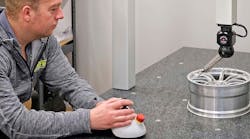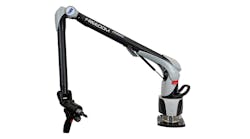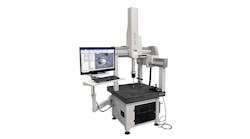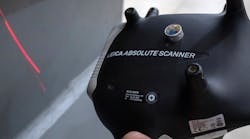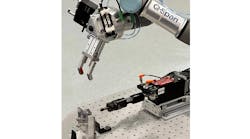Equator™, the name of the first series of gaging products from Renishaw is described as “a radical new alternative to traditional dedicated gaging.” It is a patented design that is novel both in its construction and operating approach, yet it is capable of high-speed comparative gaging for inspection of high-volume manufactured parts.
Renishaw indicates it developed and tested the equipment in shop-floor settings in collaboration with companies in the automotive, aerospace and medical sectors. As a result, the new product is a lightweight, fast, and repeatable gage that operators can use with "push-button" simplicity, according to the developer. Equator can switch between parts in seconds, perfect for flexible manufacturing processes or accepting parts from multiple machines.
Faster and more repeatable
Based on an easily scalable and adaptable "parallel kinematic" structure, the patented principle behind Equator allows high-speed scanning and rapid moves between features, while retaining the stiffness that delivers impressive point to point repeatability — and is so critical for accurate gaging.
Renishaw emphasizes that installing the Equator takes just a few minutes, and an operator can switch between gaging of different parts in seconds. Re-configuration of the gaging system to accommodate part design changes, or to measure new parts, is possible in a fraction of the time needed for conventional custom gaging, using industry standard DMIS programming.
Equator systems are available with two levels of software, a programmable version for production engineers to create DMIS programs and, at a lower price, a shop floor system that allows those programs to be executed but prevents operators from making modifications. Both software levels include easy-to-use MODUS™ Organizer operator front-end software. In the programmable version, MODUS™ Equator programming software allows engineers to rapidly create gaging routines for any part – simple or complex, prismatic or free form. MODUS Equator features the ability to program scanning measurements and touch points easily, using the industry-standard Renishaw SP25 compact scanning probe. Scanning allows thousands of data points to be taken to define a feature for true form analysis.
By taking the dongle provided with the programmable system and plugging it into a shop-floor system, full programming functionality is activated on that shop-floor system, which allows engineers to adjust programs but also retain control.
Renishaw explains that Equator's “innovative and highly repeatable” gaging technology is based on the traditional comparison of production parts to a reference master part. Re-mastering takes only as long as measuring a production part, and immediately compensates for any change in thermal conditions on the shop floor. Equator can be used in factories with wide temperature variation simply by re-mastering the system to "re-zero” it, so it’s ready for repeatable comparison to the master.
Traceability to calibrated CMMs
Master parts do not need to be expensive custom parts like a traditional gage; a production part measured on a co-ordinate measuring machine (CMM) can establish feature variation from CAD or drawing nominals. The results from any CMM, using any CMM programming software, can be configured to be used directly with the Equator software.
Effectively, the calibrated absolute accuracy of the CMM (often located in a temperature controlled room to ensure accuracy) can be "extended" onto the shop floor to provide calibrated traceability to Equator measurements. With the calibration file loaded into the Equator software, measurements made in the Equator system can be referred back to the CAD or drawing nominals. This allows true process control with SPC packages, Renishaw explains.
The Equator controller, included with every Equator system, is a powerful dedicated control system that provides a secure and robust environment for running the Equator gaging system software. It is similar to machine tool control systems, with the added ability to run Equator-specific Windows applications. Designed for Equator, it incorporates all the necessary electronic boards and software in one package. The user can create and execute DMIS measurement programs, change measurement settings and transfer data or programs.
An additional PC is not required when operating the Equator, reducing cost to the customer and eliminating the chance of incompatibility or un-predictable performance arising from the wide variation of PC architectures.
Low-cost fixturing
Compared to dedicated gaging, Equator cuts fixture costs considerably, the supplier contends. By using fixturing that positions parts to within 1 mm of where the master was measured, which has no significant effect on system repeatability, and by establishing the part orientation and datums on the part itself, the need for expensive precision fixtures is removed.
Further versatility is offered by the Equator-specific stylus changing rack (which is included in the cost of an Equator system) allowing automated in-cycle changing of SM25 stylus modules. The SM25 modules couple to the industry-standard SP25 CMM probe, so Equator users can swap stylus configurations without re-qualifying each time. Up to six stylus combinations can be loaded into the rack at any time. These can be used on a single complex part or with multiple parts of varying geometries.
Equator can be integrated into automated cells, using the optional I/O interface to connect it to a robot, or by outputting the gage results to an SPC package. Some SPC packages also offer the ability to connect to certain modern machine tool controls to update offset values, for true automated process control.





